Tom Mutch
Wed, February 22, 2023

ANTAKYA, Turkey—Hassan Hassan had been keeping vigil outside of his family’s destroyed apartment block for days now. “Three of my family members are under there,” he said, motioning to the huge expanse of rubble that thousands of people had called their home until just over a week ago.
Rescue workers usually refer to a “golden period” of 72 hours where the vast majority of survivors are found. When The Daily Beast visited Antakya, a city in Hatay province in south Turkey on the border with Syria, many people had long given up. But although it was 10 days after the original 7.8 magnitude quake hit Turkey and Syria on Feb. 6—killing upwards of 41,000 people—orange diggers and men and women in hard hats and high-vis jackets were still pulling through the rubble looking for any sign of survivors.
Around 90 different search and rescue teams have been sent from around the world in one of the most desperate efforts of the 21st century. When they—as is almost inevitable—find a corpse, they put it into a black body bag, and it is driven away by a waiting hearse.
Yet another earthquake aftershock has hit near the city of Iskenderun at the time of writing. It kills more, forces yet more evacuations and upends the lives of the survivors, who have no idea when their nightmare is going to end. Faced with the numbing scale of the tragedy, it is sometimes easy to forget the individual lives destroyed.
Hidden toll
Galal, a doctor who teaches at Burdur Mehmet Akif Ersoy University and is now volunteering to help with disaster relief, says on the outskirts of the town that “this is the worst-affected place in the country. It’s absolutely horrible in there… the government says that there are only 30,000 dead, but that’s nonsense. There must be 30,000 dead in this city alone.” The rescuers are all gaunt-faced, with heavy bags under their eyes and dirty clothing, having worked without respite for over a week.

Three rescue workers in discussion outside a building being demolished in Antakya.
They have a grisly methodology to come to this sum: multiply the amount of destroyed buildings by the average number of people living there and work out the percentage who we know were rescued. These are not official statistics, and would be very hard to independently verify, but a visit to the area led Martin Griffiths, the UN’s chief emergency relief coordinator, to say that the most horrible part of the recovery will be when we learn the true death toll. In Hatay province, people believe the earthquake will have claimed 200,000 victims throughout Turkey and Syria once it is totalled up.
In Turkey, earthquakes are commonplace, but are also intensely political, and could prove fatal to President Erdogan’s attempts to tighten his grip on power in the upcoming May elections. After a previous terrifying earthquake in 1999, which killed around 17,000 people in Istanbul, Erdogan’s AKP capitalized by promising reform and anti-corruption measures to make buildings safe and earthquake-proof. Citizens paid billions of liras in “earthquake taxes” to improve construction, but government critics say that much of this money was pocketed by corrupt officials.
Meanwhile, in a parking lot in Antakya, we found a sofa with a family’s photographs and personal documents lying around. They record the lives of the family’s young son, starting in the womb with photos of his ultrasound. Then we find a birth certificate, a baby’s birthday party, and what look to be family vacation photos. We were unable to find out whether the family was alive.

An ultrasound and family photo pulled from the wreckage of a destroyed apartment in Antakya.
Yet miracles are still occurring. The previous day, a 12-year-old girl had been dug out alive from an adjacent apartment building, giving Hassan some small hope. His family’s odds are low, however—one exhausted rescue worker estimated that they now pull out 500 corpses for every one person they find alive.
“Don’t expect to find any more,” one local official in the nearby city of Kahramanmaras told The Daily Beast privately, although they are reluctant to give up the search until the last possible moment. “We can’t talk right now, we’ve lost too many people, it’s too painful,” one Syrian family says as they sit around a fire made from abandoned clothing stacked in a rubbish bin. Rescuers and survivors alike have been using these for heat throughout the city, as utilities like electricity and running water have been completely cut off by the quake.
It is difficult to find words to portray the level of damage in this city—an ancient port town home to one of the contenders for the world’s oldest Christian church, the road to which has been blocked by debris. Possibly a third of buildings in this city, originally home to around 400,000 people, are completely flattened, with many others partially collapsed, or their foundations broken beyond repair.

Cranes searching for a family believed buried under rubble in Kahramanmaras.
On the central Inonu Boulevard is a cruel monument to the whims of fate. The buildings to the left are pristine and look completely untouched. To the right, they are almost all in ruins. Whether you lived or died that day might have depended on simply which side of the street you were in. Turkish authorities now estimate that 84,000 buildings have collapsed or sustained irreparable damage. Shopping malls, historic castles, places of worship and scores of apartment blocks are in pieces, with an unknowable number of bodies lying beneath them.
‘Open-air prison’
Millions of people have been displaced, and the safer parts of the cities away from high rise buildings are filled with camps of tents run by AFAD, Turkey’s disaster management agency. Several shipping companies are donating containers that are being rapidly converted to temporary shelters. Turkish authorities have promised to quickly build another 200,000 apartments in the region—but it was the rapid pace of building the original structures, and the corners cut in construction, that led to so many preventable deaths in the first place. Driving past fields near the cities, you can see large gravesites being hurriedly dug for the dead, who are far too many for local cemeteries to handle.

Rubble of destroyed apartment buildings in Antakya.
For many of the survivors, this is not their first brush with death. Martin Hijazi, a 26-year-old Syrian from Aleppo who works for a development NGO, said that “at least one third of the city of Gaziantep is Syrians. This has really inflamed tensions between Turkish people and the Syrian refugees. Many of the Turks hate us now, and Syrians started to get scapegoated for anything that went wrong. In one refugee camp in Mersin province, a rumor went around that Syrians were stealing food from the camp. So at midnight, they made everyone who was Syrian leave the camp, in the middle of the night, with no food and nowhere to go.”
Under Turkey’s temporary protection status for Syrian refugees, many cannot leave the province they claimed refuge in, so they are forced to stay in earthquake-prone areas. Tremors continue throughout the days; I was woken up twice by my hotel room in Gaziantep shaking.
“Even though I speak Turkish, I have citizenship, I’m still treated second-class,” says Martin, “For many of us, Turkey feels like an open-air prison.”
PHOTOS: Tom Mutch
The Daily Beast.
.
The Daily Beast.
.
No comments:
Post a Comment